Nonlinear Energy Harvesting by Piezoelectric Bionic ‘M’ Shape Generating Beam Featured in Reducing Stress Concentration
Abstract
1. Introduction
2. Design and Modeling
2.1. Design of “M” Type Power Generation Beam of Energy Harvester
2.2. Mechanical Model
2.3. FEM Optimization Design
3. Relief of Stress Concentration
4. Experiments and Analysis
4.1. Prototype Fabrication and Experimental Setup
4.2. Output Performance of the Energy Harvester
5. Conclusions
- When the height of the power generation beam in the bio-inspired bistable energy is 5 mm and the mass of the proof mass is 10 g at the resonant frequency (14 Hz), the power generation beam can break through the potential energy trap and snap-through, switching back and forth between the two stable states, like a seagull flying up and down two stages.
- The stresses of the seagull-inspired beam proposed in this paper vary continuously with the up-and-down motion of the proof mass block and can well relieve the stress concentration and thus improve its working life. In addition, the peak stress of the seagull-inspired beam is 32.34% lower than that of the parabolic (bow-shaped) beam, indicating that the seagull-inspired beam has huge potential to improve material fatigue failure.
- When the external resistance of the circuit is 47 kΩ, this model has an open-circuit peak voltage of 11.5 V and a maximum output power of 73 μW.
Author Contributions
Funding
Data Availability Statement
Acknowledgments
Conflicts of Interest
References
- Izhar; Iqbal, M.; Khan, F. Hybrid Acoustic, Vibration, and Wind Energy Harvester Using Piezoelectric Transduction for Self-Powered Wireless Sensor Node Applications. Energy Convers. Manag. 2023, 277, 116635. [Google Scholar] [CrossRef]
- Nan, W.; Yuncheng, H.; Jiyang, F. Bistable Energy Harvester Using Easy Snap-through Performance to Increase Output Power. Energy 2021, 226, 120414. [Google Scholar] [CrossRef]
- Cai, Y.; Fu, J.; Wu, N.; Xiong, C.; Liu, A.; He, Y. A High-Efficiency Curved Panel Energy Harvester Featured by Reduced Stress Concentration. Energy Convers. Manag. 2022, 271, 116334. [Google Scholar] [CrossRef]
- Yang, Y.; Shen, Q.; Jin, J.; Wang, Y.; Qian, W.; Yuan, D. Rotational Piezoelectric Wind Energy Harvesting Using Impact-Induced Resonance. Appl. Phys. Lett. 2014, 105, 053901. [Google Scholar] [CrossRef]
- Zhao, B.; Wang, J.; Liang, J.; Liao, W.-H. A Dual-Effect Solution for Broadband Piezoelectric Energy Harvesting. Appl. Phys. Lett. 2020, 116, 063901. [Google Scholar] [CrossRef]
- Yi, Z.; Hu, Y.; Ji, B.; Liu, J.; Yang, B. Broad Bandwidth Piezoelectric Energy Harvester by a Flexible Buckled Bridge. Appl. Phys. Lett. 2018, 113, 183901. [Google Scholar] [CrossRef]
- Zhao, H.; Ouyang, H.; Zhang, H. A Nonresonant Triboelectric-Electromagnetic Energy Harvester via a Vibro-Impact Mechanism for Low-Frequency Multi-Directional Excitations. Nano Energy 2023, 107, 108123. [Google Scholar] [CrossRef]
- Egbe, K.-J.I.; Matin Nazar, A.; Jiao, P. Piezoelectric-Triboelectric-Electromagnetic Hybrid Rotational Energy Harvesters (H-REH). Int. J. Mech. Sci. 2022, 235, 107722. [Google Scholar] [CrossRef]
- Imbaquingo, C.; Bahl, C.; Insinga, A.R.; Bjørk, R. A Two-Dimensional Electromagnetic Vibration Energy Harvester with Variable Stiffness. Appl. Energy 2022, 325, 119650. [Google Scholar] [CrossRef]
- Chen, L.; Ma, Y.; Hou, C.; Su, X.; Li, H. Modeling and Analysis of Dual Modules Cantilever-Based Electrostatic Energy Harvester with Stoppers. Appl. Math. Model. 2023, 116, 350–371. [Google Scholar] [CrossRef]
- Dragunov, V.P.; Ostertak, D.I.; Sinitskiy, R.E. New Modifications of a Bennet Doubler Circuit-Based Electrostatic Vibrational Energy Harvester. Sens. Actuators A Phys. 2020, 302, 111812. [Google Scholar] [CrossRef]
- Zhao, C.; Yang, Y.; Upadrashta, D.; Zhao, L. Design, Modeling and Experimental Validation of a Low-Frequency Cantilever Triboelectric Energy Harvester. Energy 2021, 214, 118885. [Google Scholar] [CrossRef]
- Bai, Q.; Liao, X.-W.; Chen, Z.-W.; Gan, C.-Z.; Zou, H.-X.; Wei, K.-X.; Gu, Z.; Zheng, X.-J. Snap-through Triboelectric Nanogenerator with Magnetic Coupling Buckled Bistable Mechanism for Harvesting Rotational Energy. Nano Energy 2022, 96, 107118. [Google Scholar] [CrossRef]
- Zhang, J.; Fang, Z.; Shu, C.; Zhang, J.; Zhang, Q.; Li, C. A Rotational Piezoelectric Energy Harvester for Efficient Wind Energy Harvesting. Sens. Actuators A Phys. 2017, 262, 123–129. [Google Scholar] [CrossRef]
- Fan, K.; Chang, J.; Chao, F.; Pedrycz, W. Design and Development of a Multipurpose Piezoelectric Energy Harvester. Energy Convers. Manag. 2015, 96, 430–439. [Google Scholar] [CrossRef]
- Kim, M.; Hoegen, M.; Dugundji, J.; Wardle, B.L. Modeling and Experimental Verification of Proof Mass Effects on Vibration Energy Harvester Performance. Smart Mater. Struct. 2010, 19, 045023. [Google Scholar] [CrossRef]
- Srinivasulu Raju, S.; Choi, S.-B.; Umapathy, M.; Uma, G. An Effective Energy Harvesting in Low Frequency Using a Piezo-Patch Cantilever Beam with Tapered Rectangular Cavities. Sens. Actuators A Phys. 2019, 297, 111522. [Google Scholar] [CrossRef]
- Keshmiri, A.; Wu, N.; Wang, Q. A New Nonlinearly Tapered FGM Piezoelectric Energy Harvester. Eng. Struct. 2018, 173, 52–60. [Google Scholar] [CrossRef]
- Xie, X.; Wang, Z.; Liu, D.; Du, G.; Zhang, J. An Experimental Study on a Novel Cylinder Harvester Made of L-Shaped Piezoelectric Coupled Beams with a High Efficiency. Energy 2020, 212, 118752. [Google Scholar] [CrossRef]
- Shan, X.; Tian, H.; Chen, D.; Xie, T. A Curved Panel Energy Harvester for Aeroelastic Vibration. Appl. Energy 2019, 249, 58–66. [Google Scholar] [CrossRef]
- Wu, P.H.; Chen, Y.J.; Li, B.Y.; Shu, Y.C. Wideband Energy Harvesting Based on Mixed Connection of Piezoelectric Oscillators. Smart Mater. Struct. 2017, 26, 094005. [Google Scholar] [CrossRef]
- Liu, H.; Zhao, X.; Liu, H.; Yang, J. Magnetostrictive Biomechanical Energy Harvester with a Hybrid Force Amplifier. Int. J. Mech. Sci. 2022, 233, 107652. [Google Scholar] [CrossRef]
- Fan, K.; Cai, M.; Liu, H.; Zhang, Y. Capturing Energy from Ultra-Low Frequency Vibrations and Human Motion through a Monostable Electromagnetic Energy Harvester. Energy 2019, 169, 356–368. [Google Scholar] [CrossRef]
- Wu, N.; He, Y.; Fu, J.; Liao, P. Performance of a Bistable Flow-Energy Harvester Based on Vortex-Induced Vibration. J. Wind Eng. Ind. Aerod. 2021, 217, 104733. [Google Scholar] [CrossRef]
- Zhao, L. Synchronization Extension Using a Bistable Galloping Oscillator for Enhanced Power Generation from Concurrent Wind and Base Vibration. Appl. Phys. Lett. 2020, 116, 053904. [Google Scholar] [CrossRef]
- Zou, H.-X.; Li, M.; Zhao, L.-C.; Gao, Q.-H.; Wei, K.-X.; Zuo, L.; Qian, F.; Zhang, W.-M. A Magnetically Coupled Bistable Piezoelectric Harvester for Underwater Energy Harvesting. Energy 2021, 217, 119429. [Google Scholar] [CrossRef]
- Huguet, T.; Badel, A.; Lallart, M. Exploiting Bistable Oscillator Subharmonics for Magnified Broadband Vibration Energy Harvesting. Appl. Phys. Lett. 2017, 111, 173905. [Google Scholar] [CrossRef]
- Cao, J.; Zhou, S.; Wang, W.; Lin, J. Influence of Potential Well Depth on Nonlinear Tristable Energy Harvesting. Appl. Phys. Lett. 2015, 106, 173903. [Google Scholar] [CrossRef]
- Wang, X.; Du, Q.; Zhang, Y.; Li, F.; Wang, T.; Fu, G.; Lu, C. Dynamic Characteristics of Axial Load Bi-Stable Energy Harvester with Piezoelectric Polyvinylidene Fluoride Film. Mech. Syst. Signal Process. 2023, 188, 110065. [Google Scholar] [CrossRef]
- Liu, C.; Zhao, R.; Yu, K.; Lee, H.P.; Liao, B. A Quasi-Zero-Stiffness Device Capable of Vibration Isolation and Energy Harvesting Using Piezoelectric Buckled Beams. Energy 2021, 233, 121146. [Google Scholar] [CrossRef]
- Chen, K.; Ding, X.; Tian, L.; Shen, H.; Song, R.; Bian, Y.; Yang, Q. An M−shaped Buckled Beam for Enhancing Nonlinear Energy Harvesting. Mech. Syst. Signal Proc. 2023, 188, 110066. [Google Scholar] [CrossRef]
- Derakhshani, M.; Momenzadeh, N.; Berfield, T.A. Analytical and Experimental Study of a Clamped-Clamped, Bistable Buckled Beam Low-Frequency PVDF Vibration Energy Harvester. J. Sound Vib. 2021, 497, 115937. [Google Scholar] [CrossRef]
- Pan, D.; Shen, Y.; Huang, C.; Wu, Z. Analysis of Snap-through Behavior of Bistable Buckled Beam under End-Moment Static Actuation. Int. J. Non-Linear Mech. 2022, 142, 103937. [Google Scholar] [CrossRef]
- Luo, H.; Liu, J.; Yang, T.; Zhang, Y.; Cao, Q. Dipteran Flight-Inspired Bistable Triboelectric Nanogenerator for Harvesting Low Frequency Vibration. Nano Energy 2022, 103, 107755. [Google Scholar] [CrossRef]
- Cha, Y.; Chae, W.; Kim, H.; Walcott, H.; Peterson, S.D.; Porfiri, M. Energy Harvesting from a Piezoelectric Biomimetic Fish Tail. Renew. Energy 2016, 86, 449–458. [Google Scholar] [CrossRef]
- Qian, F.; Hajj, M.R.; Zuo, L. Bio-Inspired Bi-Stable Piezoelectric Harvester for Broadband Vibration Energy Harvesting. Energy Convers. Manag. 2020, 222, 113174. [Google Scholar] [CrossRef]
- Fu, H.; Sharif-Khodaei, Z.; Aliabadi, F. A Bio-Inspired Host-Parasite Structure for Broadband Vibration Energy Harvesting from Low-Frequency Random Sources. Appl. Phys. Lett. 2019, 114, 143901. [Google Scholar] [CrossRef]
- Zhou, J.; Zhao, X.; Wang, K.; Chang, Y.; Xu, D.; Wen, G. Bio-Inspired Bistable Piezoelectric Vibration Energy Harvester: Design and Experimental Investigation. Energy 2021, 228, 120595. [Google Scholar] [CrossRef]
- Zhang, Y.; Jeong, C.K.; Yang, T.; Sun, H.; Chen, L.-Q.; Zhang, S.; Chen, W.; Wang, Q. Bioinspired Elastic Piezoelectric Composites for High-Performance Mechanical Energy Harvesting. J. Mater. Chem. A 2018, 6, 14546–14552. [Google Scholar] [CrossRef]
- Yang, B.; Yi, Z.; Tang, G.; Liu, J. A Gullwing-Structured Piezoelectric Rotational Energy Harvester for Low Frequency Energy Scavenging. Appl. Phys. Lett. 2019, 115, 063901. [Google Scholar] [CrossRef]
- Li, J.; Fu, G. Structure Design and Simulation Analysis of Two-Stage Bionic Flapping Wing Aircraft. Master’s Thesis, Beijing Jiaotong University, Beijing, China, 2020. [Google Scholar] [CrossRef]
- Wu, R.; Zhou, C. Design and Experimental Study of Two-Stage Flexible Flapping Air Vehicle. Master’s Thesis, Harbin Institute of Technology, Harbin, China, 2019. [Google Scholar] [CrossRef]
- Li, H.; Ding, H.; Chen, L. Chaotic dynamics of a bi-stable energy harvesting system with asymmetric potential well characteristics. J. Vib. Shock 2020, 39, 54–59+69. [Google Scholar]
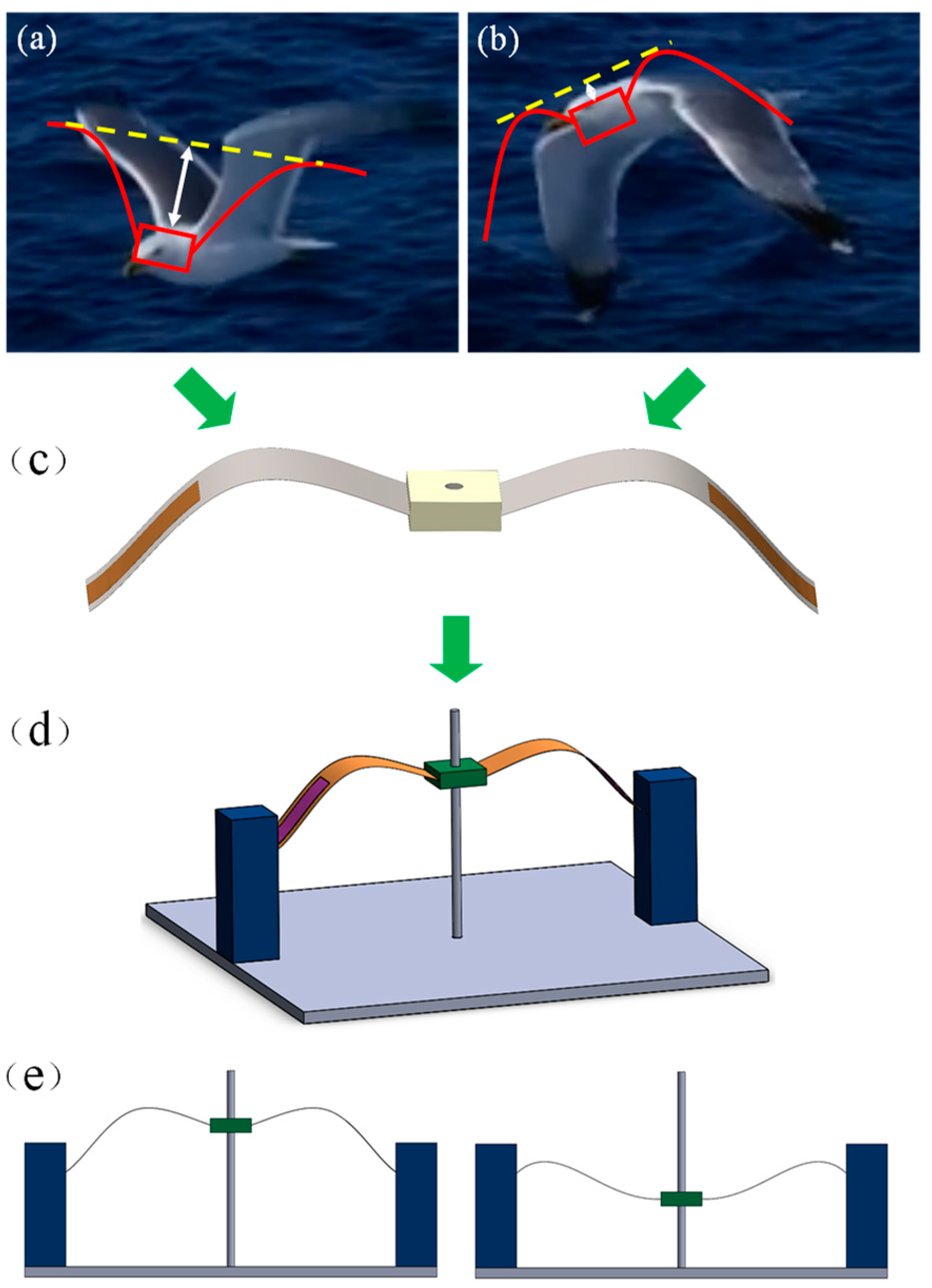
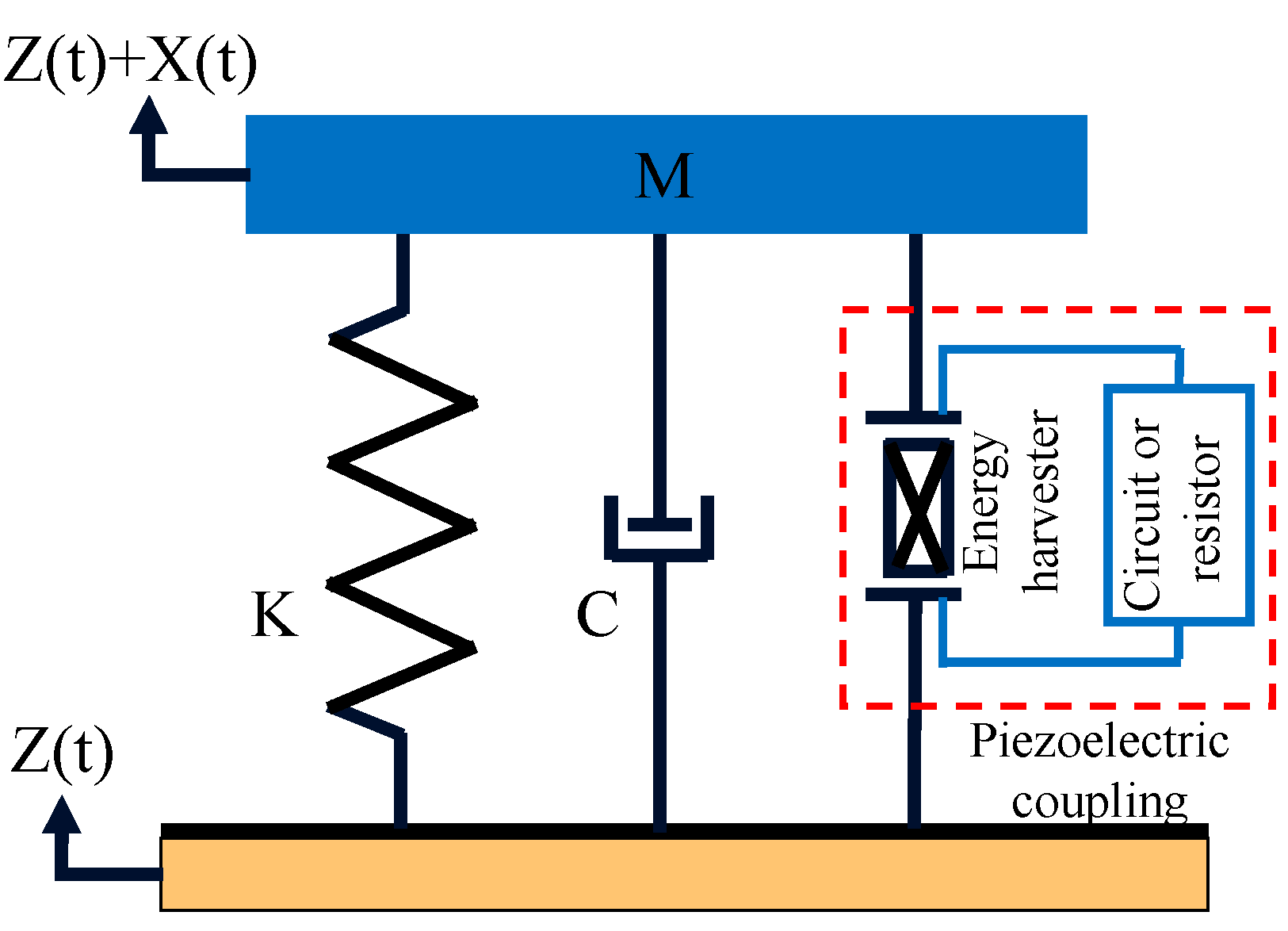
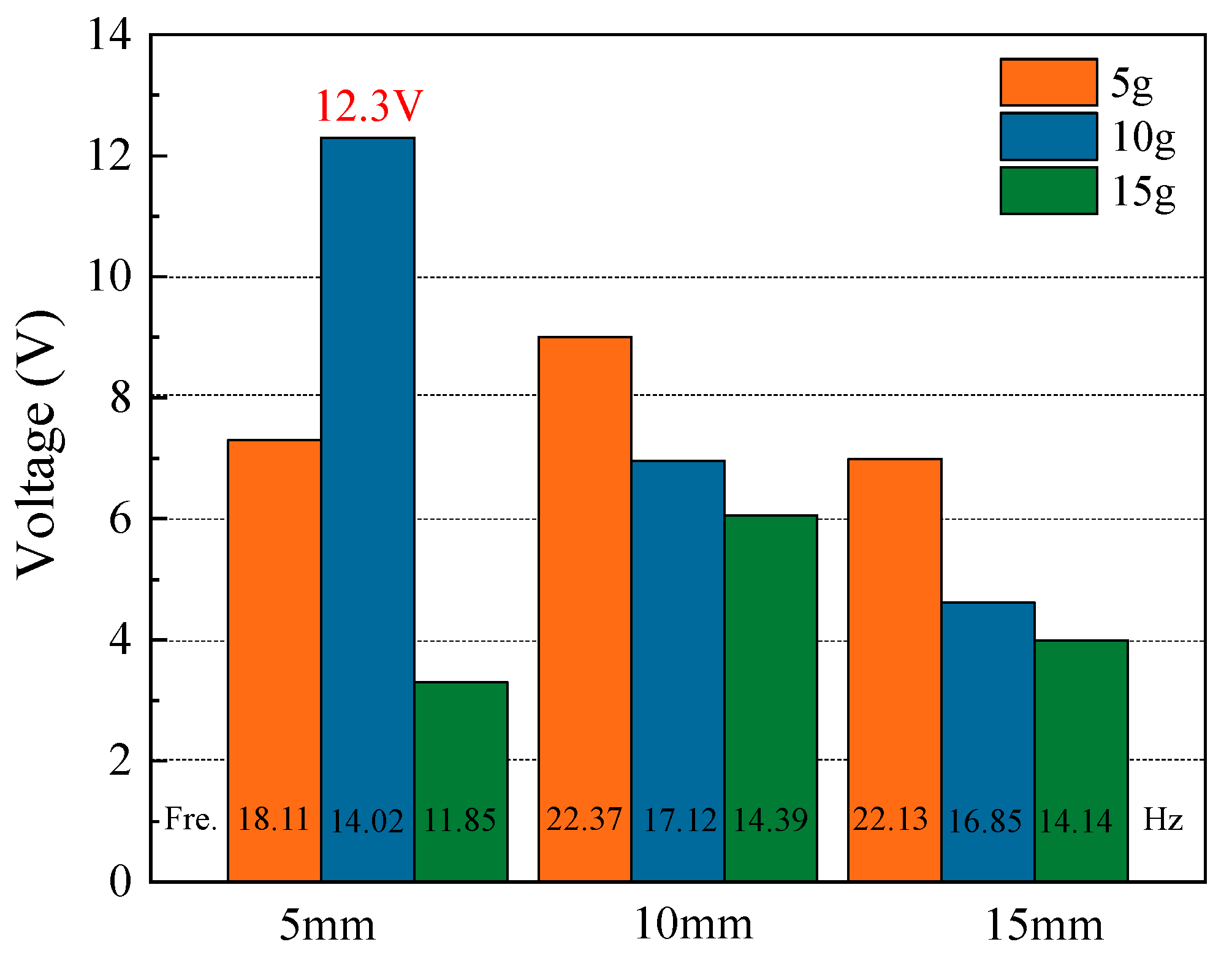
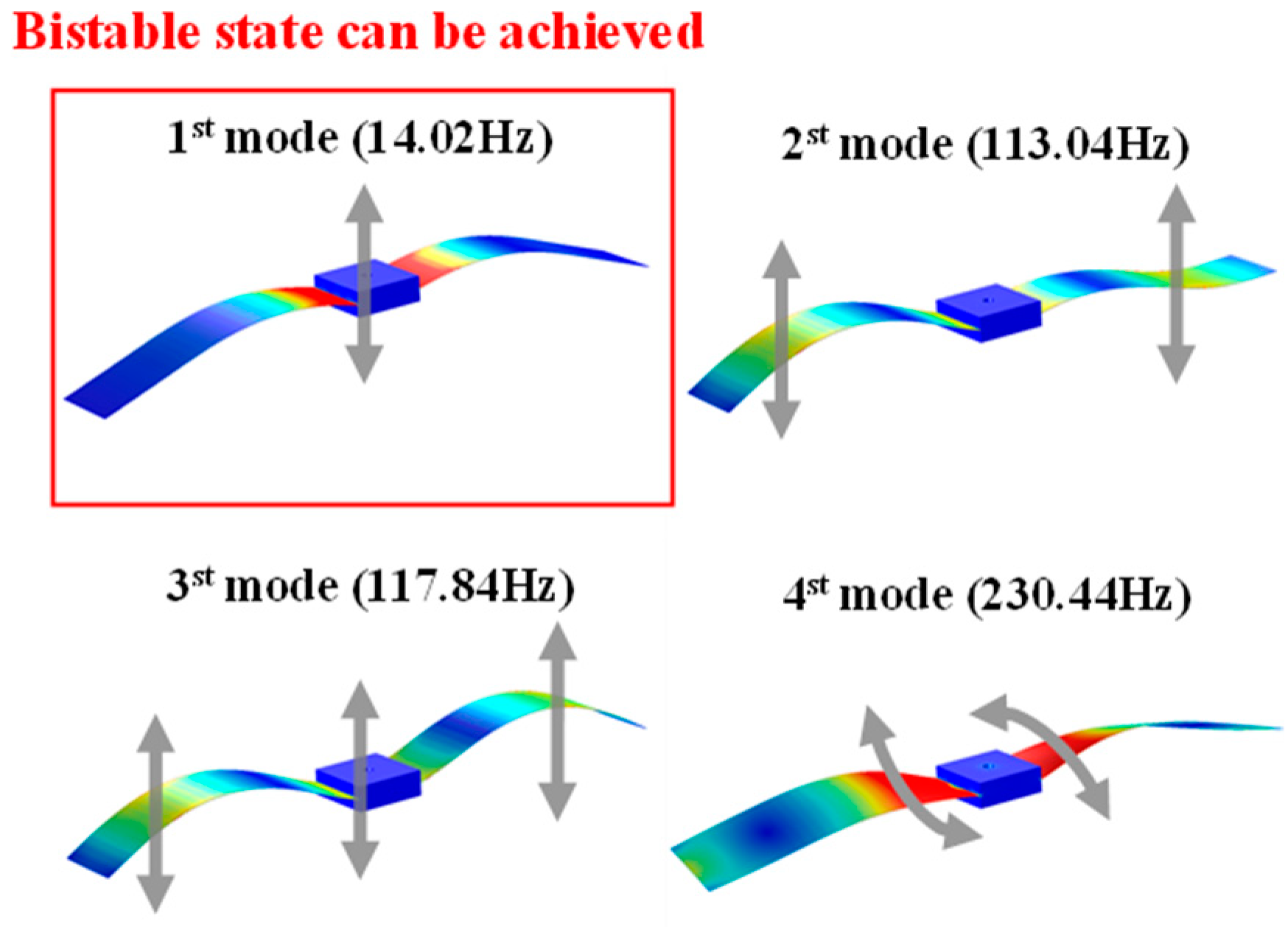
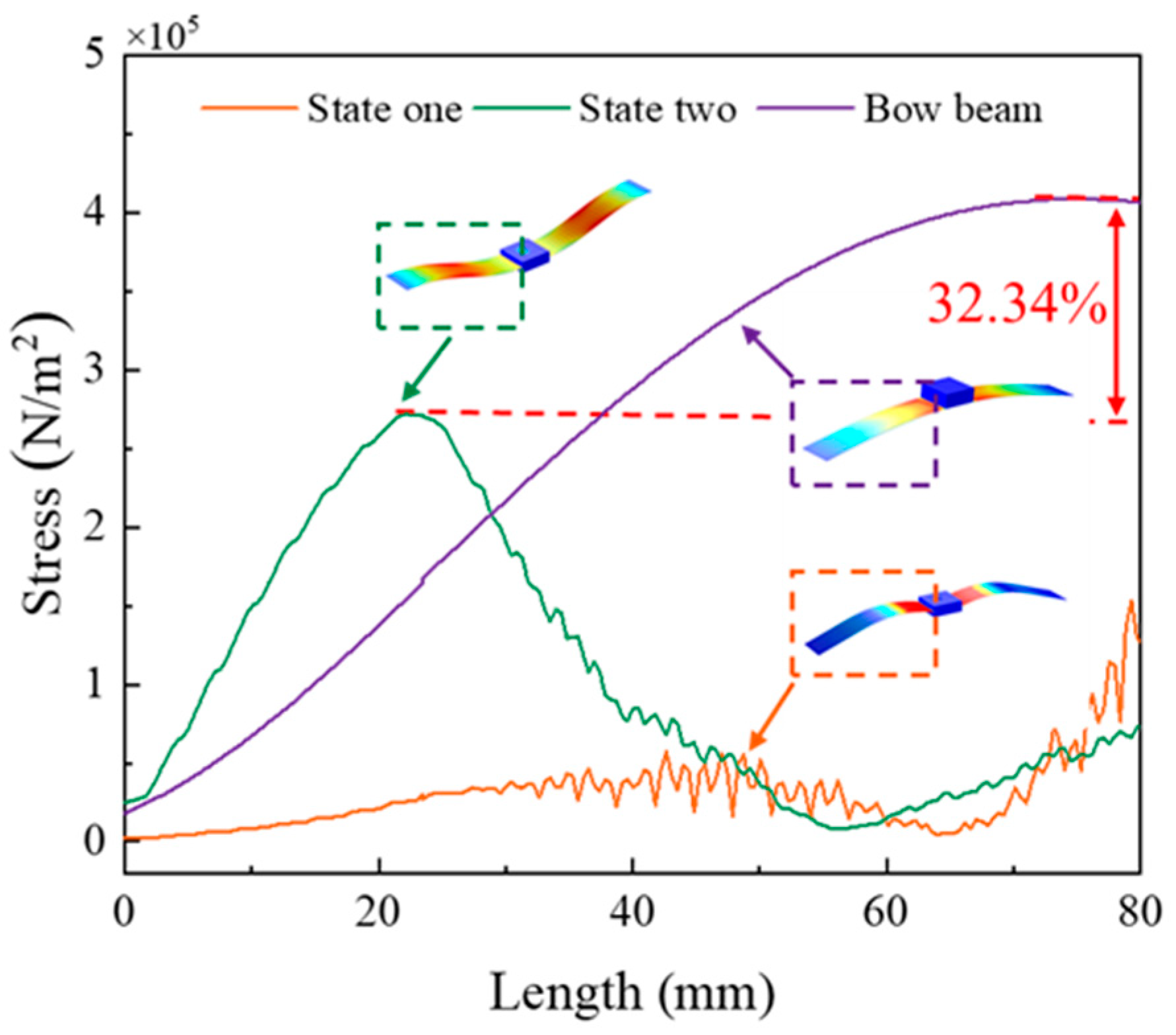
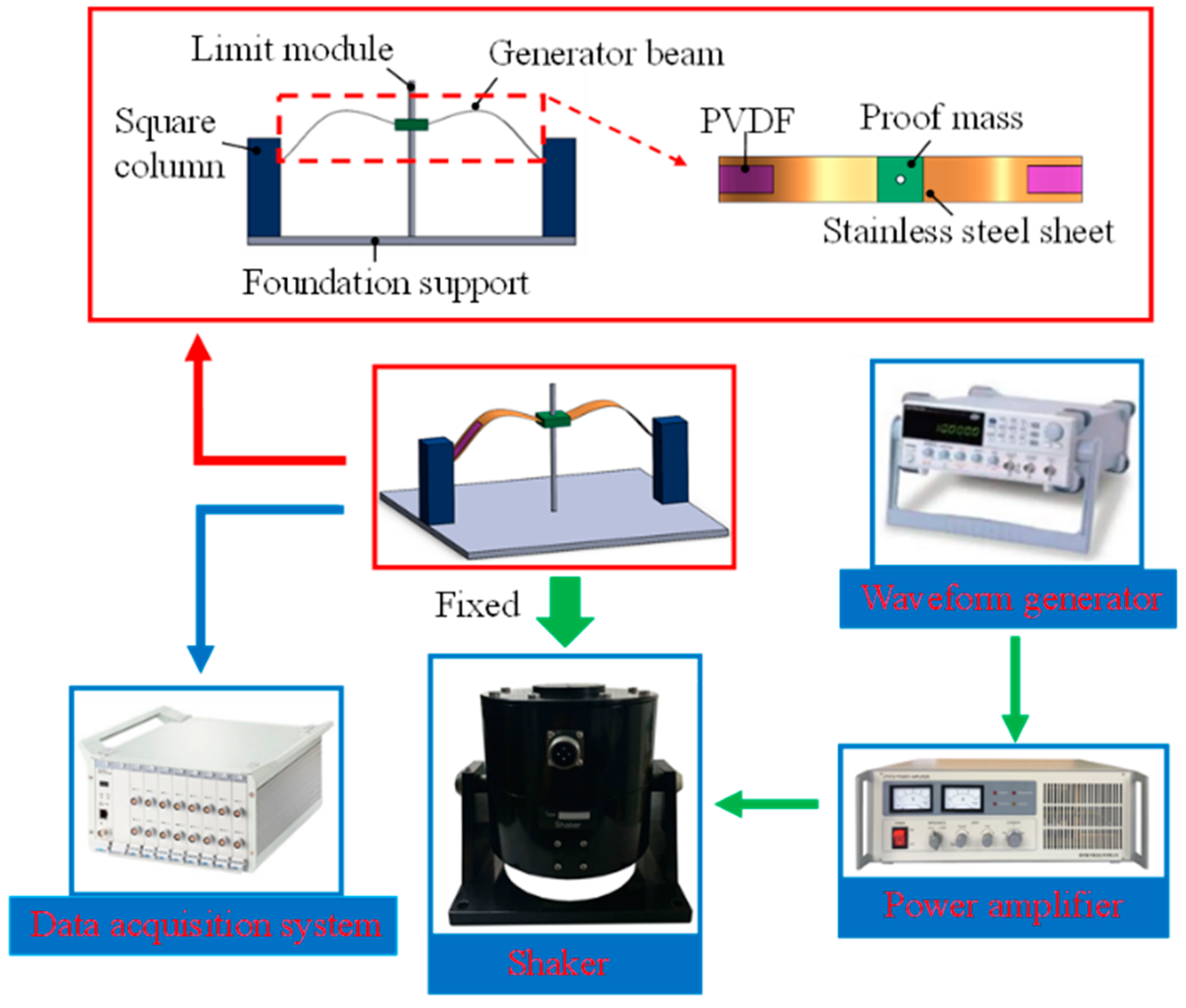
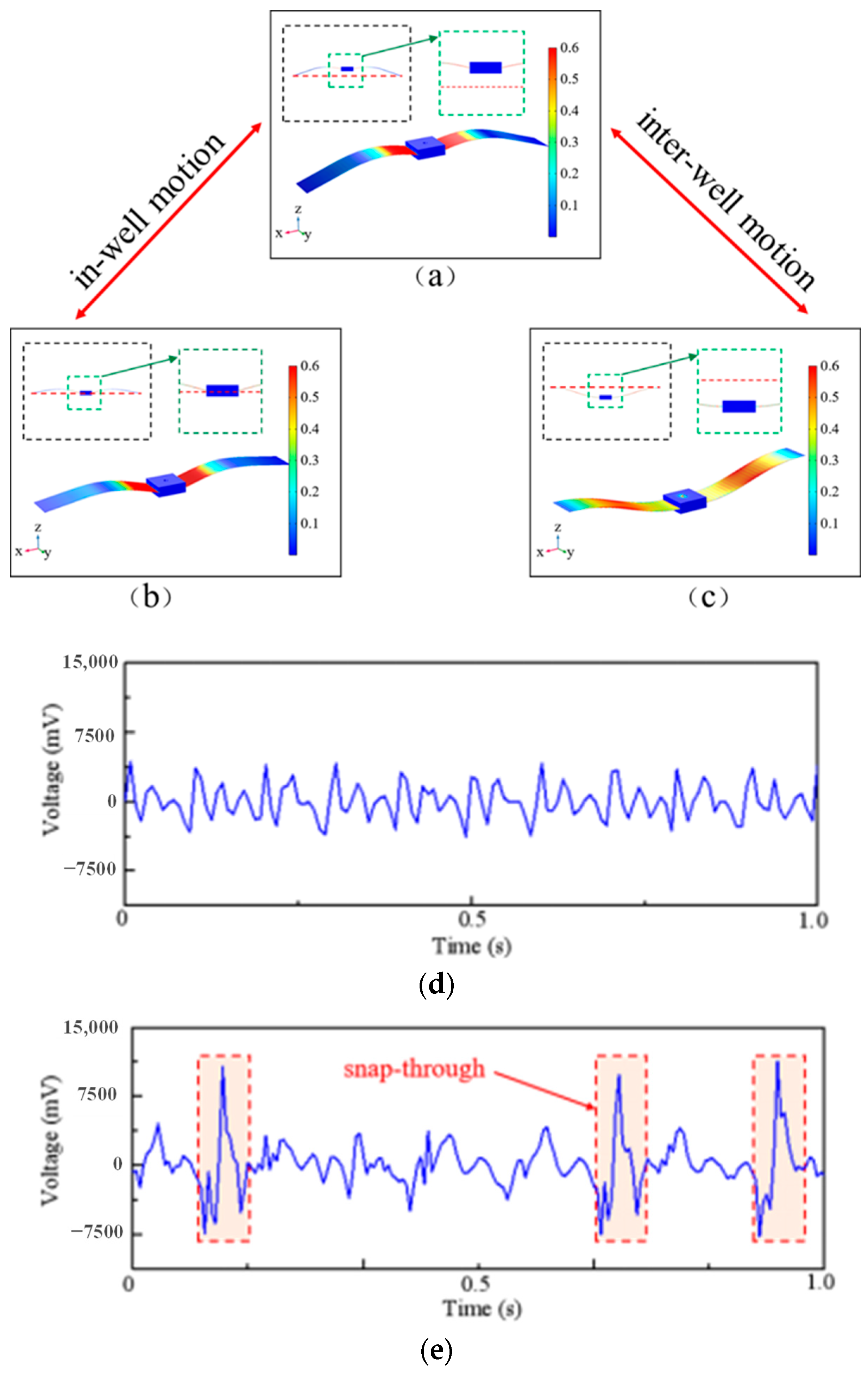

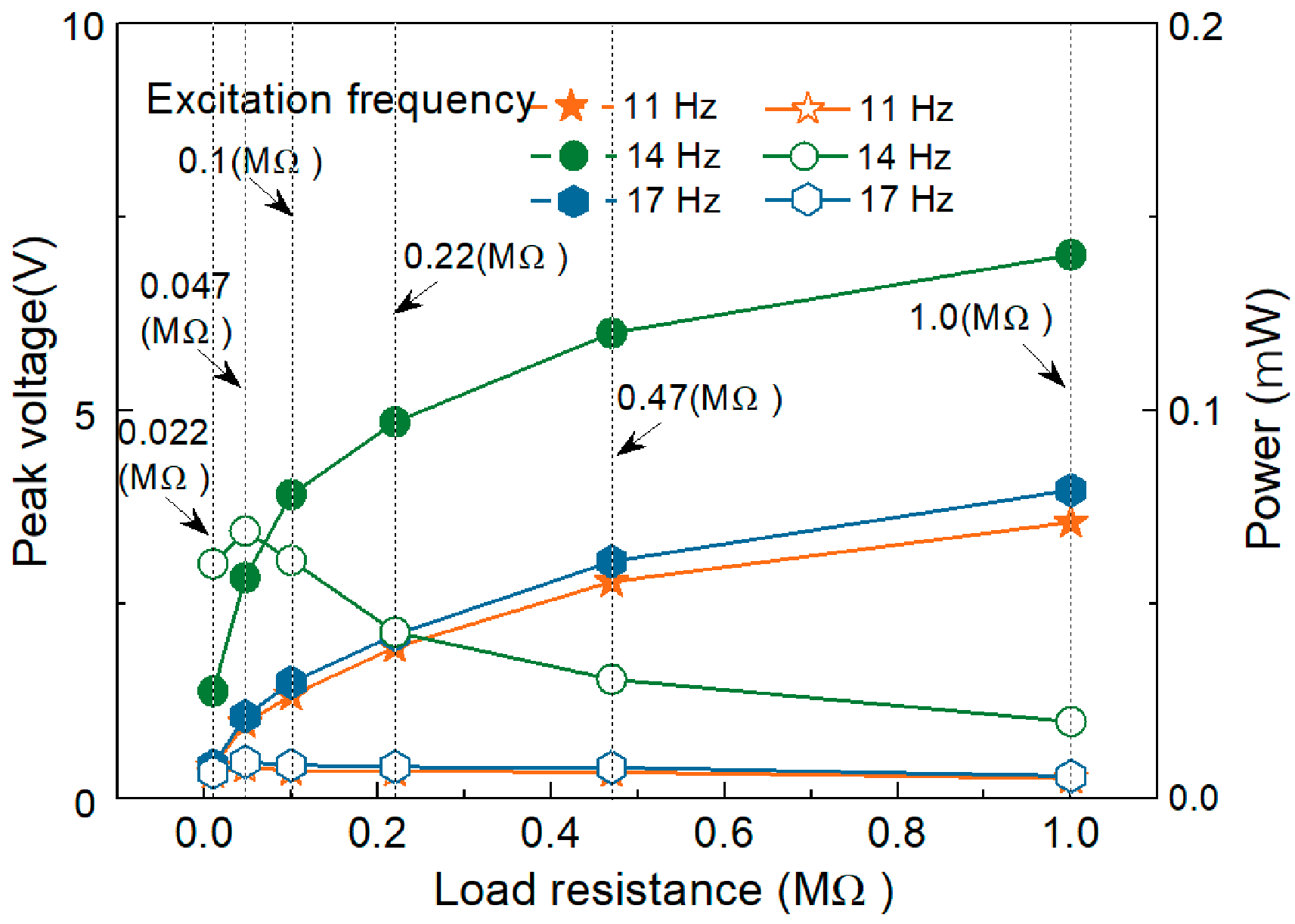
| References | Operation Mechanism | Piezomaterial Volume (mm3) | Central Frequency (Hz) | Accel. (g) | Power (μW) | Power Density (mW/cm3) |
|---|---|---|---|---|---|---|
| Huguet et al. [28] | Bistable and subharmonic | 28 × 10 × 0.1 | 120 | 0.51 | 269 | 9.6 |
| Chen et al. [32] | Buckling | 20 × 10 × 0.3 | 8.2 | 5 | 12.2 | 0.20 |
| Yi et al. [6] | Bi-stability | 16 × 5 × 0.05 | 105.3 | 2 | 600 | 150 |
| Fu et al. [30] | Buckling Plucking | 26.5 × 1.5 × 0.2 26.5 × 1.5 × 0.2 | 23 24.5 | 0.25 0.08 | 10.6 5.2 | 1.34 0.66 |
| This work | Bi-stability | 30 × 16 × 0.1 | 14 | N/A | 73 | 1.52 |
Disclaimer/Publisher’s Note: The statements, opinions and data contained in all publications are solely those of the individual author(s) and contributor(s) and not of MDPI and/or the editor(s). MDPI and/or the editor(s) disclaim responsibility for any injury to people or property resulting from any ideas, methods, instructions or products referred to in the content. |
© 2023 by the authors. Licensee MDPI, Basel, Switzerland. This article is an open access article distributed under the terms and conditions of the Creative Commons Attribution (CC BY) license (https://creativecommons.org/licenses/by/4.0/).
Share and Cite
Xiong, C.; Wu, N.; He, Y.; Cai, Y.; Zeng, X.; Jin, P.; Lai, M. Nonlinear Energy Harvesting by Piezoelectric Bionic ‘M’ Shape Generating Beam Featured in Reducing Stress Concentration. Micromachines 2023, 14, 1007. https://doi.org/10.3390/mi14051007
Xiong C, Wu N, He Y, Cai Y, Zeng X, Jin P, Lai M. Nonlinear Energy Harvesting by Piezoelectric Bionic ‘M’ Shape Generating Beam Featured in Reducing Stress Concentration. Micromachines. 2023; 14(5):1007. https://doi.org/10.3390/mi14051007
Chicago/Turabian StyleXiong, Chao, Nan Wu, Yuncheng He, Yuan Cai, Xianming Zeng, Peichen Jin, and Minyi Lai. 2023. "Nonlinear Energy Harvesting by Piezoelectric Bionic ‘M’ Shape Generating Beam Featured in Reducing Stress Concentration" Micromachines 14, no. 5: 1007. https://doi.org/10.3390/mi14051007
APA StyleXiong, C., Wu, N., He, Y., Cai, Y., Zeng, X., Jin, P., & Lai, M. (2023). Nonlinear Energy Harvesting by Piezoelectric Bionic ‘M’ Shape Generating Beam Featured in Reducing Stress Concentration. Micromachines, 14(5), 1007. https://doi.org/10.3390/mi14051007







